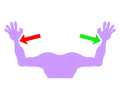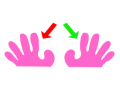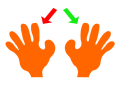Handwriting warm up exercises
Before starting to work on letter formation, joins or even the pre-handwriting patterns it is a good idea to help focus your child's body on the activity that it is about to be performed in a fun and relaxed way.
The exercises only take a couple of minutes to do. Not only can they be done at the beginning of the session but throughout and at the end to help relax muscles and release tension that may build up over the session. Tense muscles can make handwriting activities difficult and tiring for your child.
Five areas to support the body with handwriting are covered in the warm up exercises:

Shoulder stability and strength
When we talk about the shoulder, we are actually referring to the shoulder girdle a number of bones, ligaments, muscles and tendons that work together to support arm strength and give the full range of arm movements.

Crossing the mid-line
To make handwriting comfortable the writing arm has to be able to cross the vertical central line of the body (crossing the mid-line). It is a key skill that enables us to write comfortably with the paper positioned appropriately and to sit at a desk correctly.

Wrist strength and flexibility
Having the full, pain free, range of wrist movements and the strength to hold the correct, slightly extended, position for handwriting is important. In this position the tendons, which run over the wrist bones, can work the finger muscles more easily giving better finger control for handwriting.

Thumb and finger strength and dexterity
Thumb and finger strength are important for the coordinated movements and strengths required to hold and maintain an efficient pencil grip as well as to move the pencil effectively for handwriting and drawing.

Whole hand strength and dexterity
Whole hand dexterity and strength is important for in-hand manipulation, grip and grip release skills as well as being able to judge the appropriate amount of pressure required to hold and release items safely, all required for handwriting.
Try to do the exercises before starting handwriting. During or after a handwriting task, and depending on the area of the body which your child may say is aching or tired, repeat the appropriate exercise. For instance, if they say their shoulders or neck are aching repeat the ‘Hand Pushes’ exercise from the Shoulder Stability section.
Remember tense muscles can make handwriting hard work and will tire your child more quickly.
Shoulder stability
Crossing the mid-line
Lazy 8
Hold your right arm straight out in front of you. Keeping your arm straight trace a large "lazy eight" (a figure of 8 on its side) 5 - 8 times in the air, so that the drawing hand crosses the middle of the body. Repeat with the other arm. Track your hand with your eyes while keeping your head still.






